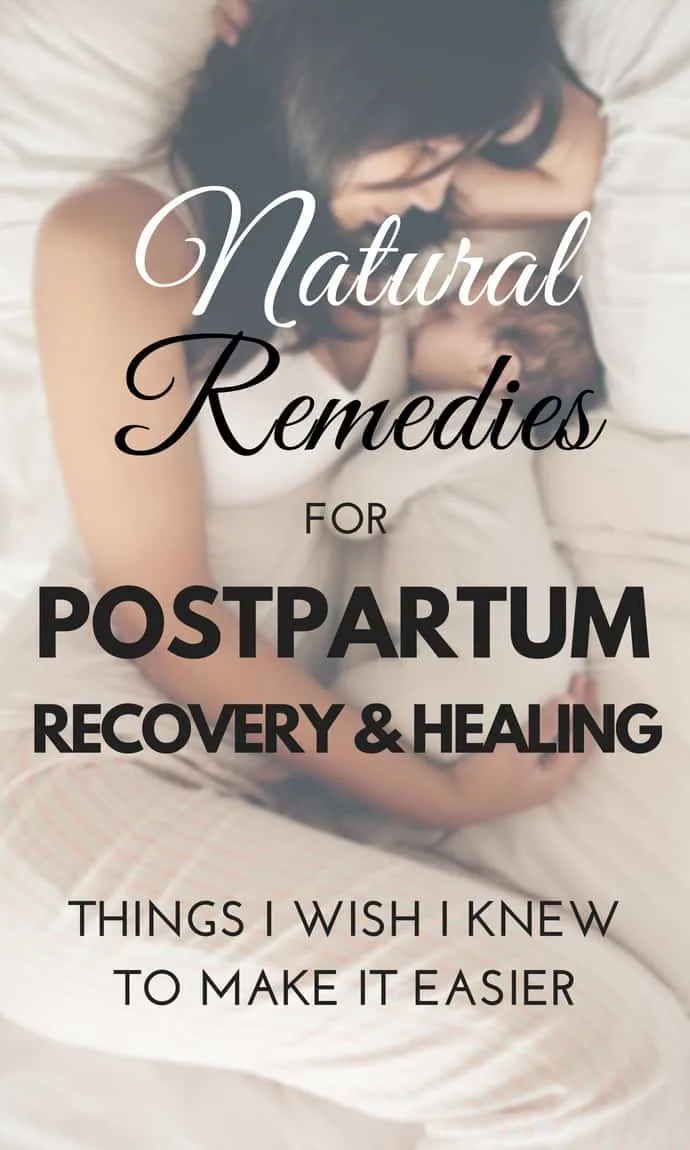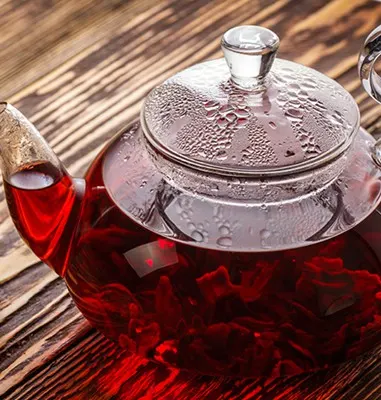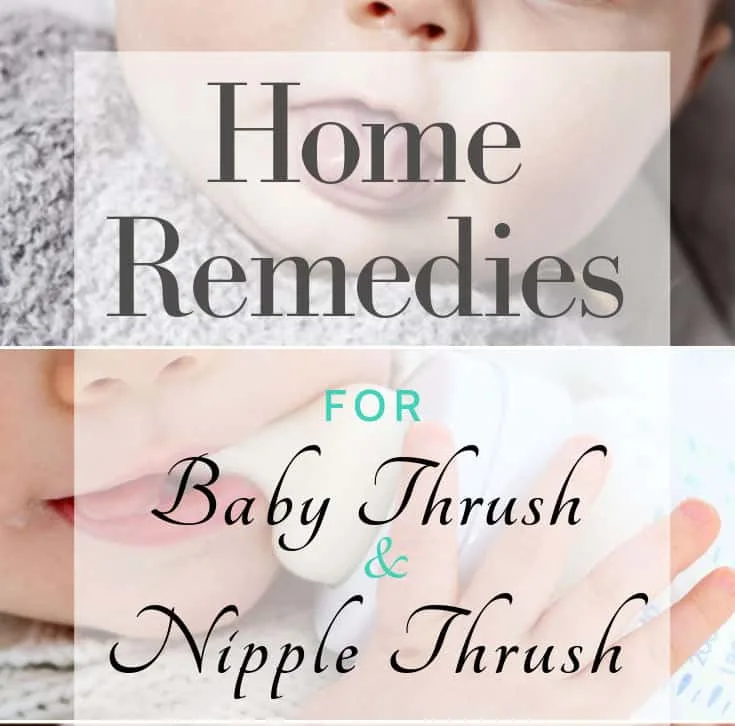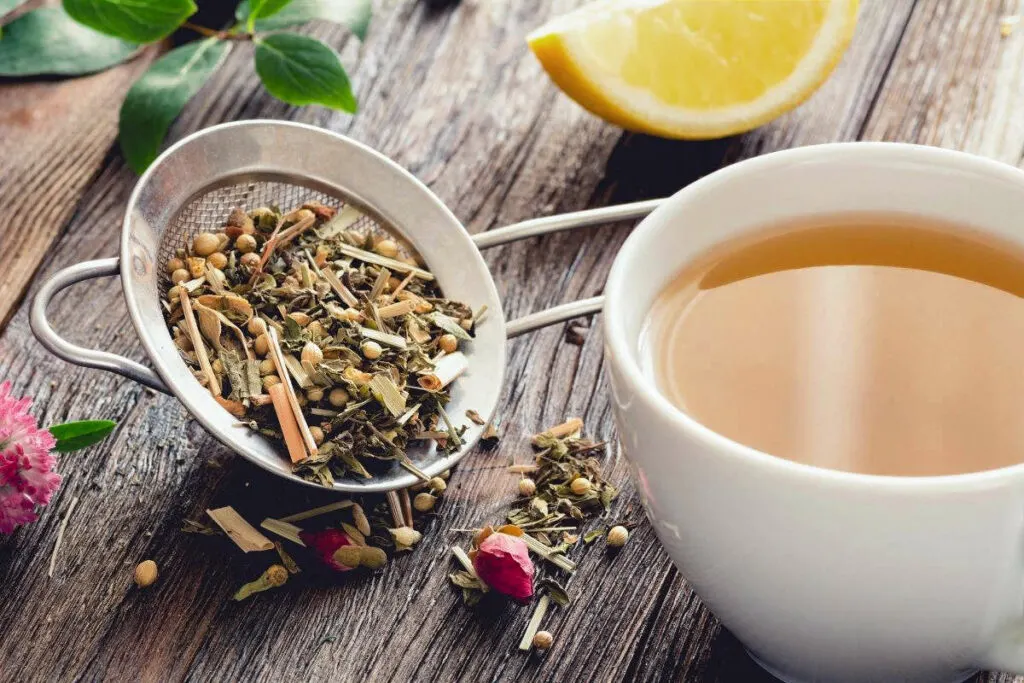Are you contemplating healing naturally after childbirth? Then you’ve come to the right place. I’m sharing some natural postpartum recovery essentials, tips and natural remedies that helped me have a natural postpartum recovery without using synthetic medications. Using only herbs and natural remedies for postpartum care will allow the body not only to recover its strength faster but also increase it’s healing potential.

Healing After Birth And What You Actually Need
It’s really important to make your postpartum recovery and healing faster and easier. This will provide you with more emotional strength to go through this experience and offer all the care your baby needs.
New mothers usually are told by health care providers that they will recover and get back to normal within six weeks of giving birth, but I would say this is rarely the case. Most women take much longer till their body and mind fully recover.
Even if in a few weeks you feel like you almost healed, the exhaustion, the emotional drain and hormonal fluctuations will make you feel like a train wreck.
The thing that many mothers are expected to be back to pre-baby responsibilities within six weeks it’s so unrealistic. Moreover the postpartum care in America usually consists of just one visit with the doctor for a vaginal (or C-section) and breast exam.
You are also offered birth control and that’s pretty much all, the rest is up to you. In case you encounter any complications, you have to seek out your own resources for specialized providers or breastfeeding support.
If you attended prenatal education classes you probably already know that they are focused almost entirely on the birth itself, and barely discusses the postpartum recovery period.
I was told by many that I shouldn’t worry about packing a hospital bag because they provide everything you need.
But, If you prefer a more natural approach to your postpartum healing I would say that you should definitely need to pack your own things.
Things I Wish I Knew About Postpartum Recovery And Healing
I never really worried about how I would feel after birth because my pregnancy was perfect, no morning sickness, no gestational diabetes, no abnormal cravings.
I had normal blood pressure, I was working out and eating healthy and overall everything felt good. I was concerned mainly with the labor, I thought that everything else will sort itself out and giving birth is the finish line.
But everything turned out different. There were many things that I did not expect. I didn’t know how hard and how long it would be to get my body back to normal.
Among the postpartum side effects that took me by surprise and seriously affected me, were: back pain, headaches or whole body aches, night sweats, engorged breasts and clogged ducts, depression, anxiety, and chronic exhaustion.
It took about a year (I was breastfeeding the whole time) until my body and mind was back on track. Maybe if I had known from the beginning what’s going on, then I could have recovered even sooner.
Every woman’s childbirth experience is different so everyone will recover at a different rate according to their state of health before and during pregnancy.
If you pushed for two hours or tore while birthing a 10 pound baby, you’re going to have a tougher postpartum recovery.
My labor lasted 18 hours with very painful contractions, I got an epidural after 12 hours, pushed for the last 2 hours and gave birth to a perfectly healthy 7.8 pound baby girl. So I didn’t expect any complications after.
What I learned later is that your postpartum recovery also depends on your immune system.
If you have any kind of chronic conditions or autoimmune issues, you will experience an amelioration during pregnancy as the immune system shifts to accommodate and protect the baby. But the symptoms appear to worsen or begin after birth, as the immune system shifts again due to the toll on your body and hormonal changes.
More information about this you can read here. Since I was experiencing symptoms of hypothyroidism and gastrointestinal sensitivities (and food intolerances) before pregnancy, I didn’t know that they can come back with a vengeance after.
And I think that receiving multiple drugs (epidural, antibiotics, oral painkillers) during labor exacerbated the situation.
Natural Remedies For Postpartum Healing That Worked For Me
I wish someone told me these things that I found out after giving birth. I wish I knew what do I really need for postpartum recovery and that there many natural remedies for postpartum healing available.
So here is a list of postpartum recovery natural remedies that could make your postpartum healing (after a natural birth) easier:
Dealing With Postpartum Pain
You will experience pain in different areas of your body. First of all, contractions for several days after delivery (similar to heavy period pain), particularly when you breastfeed. Nursing helps your uterus to tighten and shrink back to its normal size.
Another thing that will help to tone your uterus and help with the postpartum pain in general, is drinking red raspberry leaf tea, nettle tea and yarrow tea. These help slow down the flow of bleeding too. You can either drink them separately or combined but I found this 3 herb combo works even better.
After a vaginal delivery, the vagina will be swollen and bruised for up to a week or two. And if you had episiotomy (a cut in the area between the vagina and anus) and perineal tears then the pain will be worse. Going to the bathroom with all that soreness is not pleasant.
Having a peri bottle handy filled with warm water each time you go to pee helps lessen the sting and keeps the area clean. The hospital usually gives you one, but It’s quite inconvenient to use, so I found something even better – Fridet.
I had episiotomy stitches and the hospital staff offered ice packs layered with witch hazel pads for the first nights. They also brought ibuprofen every 6 hours for the pain (took it for a week, even after I got home).
Although they said that it’s compatible with breastfeeding, I wish I knew then that these medications are not completely harmless because they have been associated with adverse cardiovascular, gastrointestinal, and renal side effects.
And having them in breast milk poses a greatest risk to newborns as they have a lower capacity to metabolize and excrete drugs. So, if I could go back, I would choose a more natural approach: a natural pain reliever – like arnica (pellet form) and arnica infused oil to massage the perineum. These are well known for their properties to relieve muscle pain, stiffness and swelling from injuries.
After 3 days, upon arriving home the first thing I did was to make a healing salve for my perineal soreness: I mixed 2 oz of mango butter with 2 Tbsp of coconut oil and melted them in a double boiler. When it cooled down I added 10 drops of organic frankincense oil and 10 drops of myrrh essential oil.
These are two of the most powerful essential oils for reducing pain and inflammation, which makes a great natural alternative for natural postpartum healing. It’s important to choose quality essential oils, as they are absorbed in the bloodstream.
For the next time this is a “must have” in my postpartum recovery, and I have to make it in advance!
Helpful Postpartum Bath Herbs
Another great remedy for a sore pelvic floor is to have a herbal sitz bath. The hospital provided me a sitz bath that goes on top of the toilet and I brought it home. You can also purchase one at you local pharmacy. I was really surprised. I knew the benefits, but using only warm water as they suggested, wasn’t helping at all.
So as soon as I got home I made my own herbal infusion (yarrow, calendula, chamomile and plantain leaves). These are really great herbs for a postpartum bath with soothing anti-inflammatory properties. The procedure is to steep 1 oz of the herb blend in 1 qt. of boiled water for at least 30 minutes.
Then pour the water into the sitz bath and soak your bottom for 20 minutes twice daily for the first week. Another option if you want to use herbs for postpartum bath is this pre-made sitz bath soak with herbs, Epsom salt, witch hazel and oils, which is also great for hemorrhoid treatment.
To be honest, the herbal sitz baths alternated with the healing perineum salve I made, was much more helpful than the which hazel pads and the ice packs provided by the hospital! I would say these two were the functional remedies for my postpartum healing.
Postpartum Bleeding
Postpartum bleeding can be compared to a heavy period. This is your body’s way of shedding the lining of the uterus and the excess blood. It is heaviest for the first 3 to 10 days or so, then it will gradually reduce in the next 2-3 weeks.
Hospitals provide large, absorbent pads for the first few days postpartum, but you’ll need to buy some more. You can opt for some disposable period underwear for comfortable sleeping and cotton pads for heavy absorbency during the day.
Postpartum Hemorrhoids
Hemorrhoids are swollen veins in the rectal area, mine developed while I was pushing for 2 hours during labor. They became very painful after a week or so, I couldn’t sit down without discomfort. I could sit comfortably only on a donut pillow while nursing. Most of the time I had to stand or lay down.
For healing postpartum hemorrhoids I did several things:
- Sitz baths mentioned earlier 2-3 times a day.
- Suppositories. I made my own suppositories at home. Recipe: in a glass container melt 2 Tbsp mango butter (or cocoa butter) + 2 Tbsp coconut oil, crush 3-4 garlic cloves, add 10 drops of yarrow essential oil and 5 drops of turmeric essential oil. Mix, pour into molds, freeze. Cut as needed and use in the morning & night. Or after each bowel movement if you want faster results.
- Changes in diet. I had to quit sugary foods, dairy and gluten, basically all inflammatory foods. I adopted an anti-inflammatory diet rich in whole foods and fermented foods.
Postpartum Constipation
If you received an epidural in the hospital, this could slow down your bowel movements, especially when you already had problems with regularity before. Take a stool softener when offered at the hospital and then continue with easy to digest foods, fiber and lots of liquids and again fermented foods. They help with restoring the gut flora and keeping you regular. If you don’t have access to fermented foods, choose a high quality probiotic supplement. This is super important for having a soft stool.
I believe that having dried prunes as a snack before and after delivery plus lots of probiotics has been really helpful. The fiber and the good bacteria made sure I get a normal intestinal food transit.
Postpartum Body Ache And Fatigue
Hormonal and posture changes, strained abdominal muscles, bending and baby lifting, are all making you feel achy and exhausted. I was struggling to get up for my newborn baby and make it through the day.
The exhaustion I felt was abnormal and overpowering. These could be seen as minor problems, but they are not minor for new mothers who are drowning in responsibilities already.
One of the causes could be the development of postpartum thyroiditis which is an inflammation of the thyroid following delivery. It lasts about 2 to 6 months postpartum. This hyperthyroid state is believed to be transient and then returns to normal by the end of the postpartum year.
In this case the goal is to do what is necessary to improve the health of the immune system because postpartum thyroiditis is an immune system condition, not a thyroid condition. So it’s important to:
- Remove the autoimmune trigger that could be a food allergen, and heal the gut;
- Eat foods that are organic and unprocessed;
- Take a good quality multivitamin and fatty acid on a daily basis;
- Use cleaners and cosmetics that don’t have any harmful chemicals;
- Stay outside in the sun when possible (for vitamin D);
- Supplement with magnesium, the best is magnesium oil applied topically which is better and safer than oral supplements. Magnesium is known for its role in optimal thyroid function and muscle relaxation, energy production, deactivation of adrenaline, cramp relief and constipation ease.
Painful Breastfeeding & Enlarged Breasts
During the early weeks of nursing, your breasts may produce an irregular quantity of milk. You may become engorged if you’re not able to nurse the baby frequently or thoroughly enough to empty the breasts.
I had an overabundance of milk and my baby couldn’t cope, therefore I developed plugged ducts and almost mastitis. As I was trying to release some pressure from my breast by pumping, my body started to produce even more milk due to stimulation. I didn’t know that at the time. It was very painful and frustrating. Here are some tips that helped with the problem:
- Pump or hand express just enough milk to get through the first letdown or only when you feel breasts are hard and engorged.
- The use of a nipple shield, will help the baby cope with the flow and protect your nipples.
- Herbal teas or oils (for massage) that reduce milk supply like oregano, lemon balm, mint, sage.
- Stock on breast pads to soak up milk leaking. You can choose between reusable and disposable. I used both.
Clogged Ducts, Breast Infection (Mastitis)
I thought the engorgement is the worse that can happen, but when I felt lumps and my breasts became red, swollen with tender patches, I knew something is wrong. I had to act fast, as a clogged duct can lead to mastitis if not properly treated. After consulting with a lactation specialist, here is what I did:
- Between feedings, I soaked my breasts in warm salty water for 10 minutes (by leaning forward), it helped especially when the pump didn’t.
- I massaged from the chest toward the nipple area before nursing. I fed with the affected side first.
- I used gel breast packs to apply heat or cold while I was in bed.
- I fed the baby at regular intervals and avoided to sleep through the night.
- Consumed raw garlic, 3-4 cloves a day. Chopping the clove into pieces was easier to swallow with water. Raw garlic acts as an antibiotic, without the added side effects of developing of yeast infections.
- Phytolacca pellets – a homeopathic remedy to treat mastitis, especially for cracked nipples and blocked milk ducts.
After Birth Sore Nipples
On top of all other problems I also had sore, cracked nipples. Even though cracked nipples are often a symptom of incorrect breast-feeding, my throbbing red nipples were induced by thrush (yeast infection). Mainly as a consequence of receiving IV antibiotics during labor.
Shortly after a week the nipples became red shiny and itchy, the burning sensation made the breastfeeding process unbearable. The prescribed nystatin and the anti-fungal cream didn’t help. Here is what worked for me:
- Soaking nipples in a water + apple cider vinegar solution (1 cup water and 1 tbsp vinegar) between breast-feedings.
- Wiping with a Grapefruit Seed Extract Solution, more is explained here.
- I applied a nipple cream made with natural ingredients with healing properties after breastfeeding. I used a natural nipple cream from Motherlove.
- Probiotics orally in large doses, plus I applied some probiotic powder on the nipples before breastfeeding. This is also helpful for baby’s oral thrush.
Postnatal Hunger And Weight Fluctuations
The first month you drop some weight and you’re not that hungry but after a couple of weeks you cannot stop eating. I was always thinking what to eat next and of course I gained some extra pounds. I think the most important is to eat the healthiest diet possible, exercise as much as possible, and not worry about it so much. If you have someone who can cook for that’s a great bonus!
Postpartum Emotional State
In the first weeks and even months after the baby is born, many women experience mood swings and unusual feelings. You may feel deeply affected emotionally by everyone and everything and the inability to cope with the new demands make you even more emotionally unstable.
And forget the difference between night and day. All your baby’s needs now become a round-the-clock job with no breaks. And if you’re having difficulty breastfeeding, sleep deprivation, and no social support at home, no wonder you will become anxious and depressed.
What can improve your emotional state during your postpartum recovery:
- Ask for help with housekeeping and cooking. Let people you trust stay with your baby or change a diaper. Don’t feel you have to do it all yourself.
- Spend time with people. Don’t isolate yourself. Talk to other mothers.
- Make time for yourself and for activities you enjoy, go for a short walk in the sun by yourself if you can.
- Since this is due in part to hormonal changes, use magnesium oil topically. It will make a huge difference by keeping stress levels low and ensure a better sleep for you and the baby.
- Evening primrose oil – aids in hormonal balance, breast pain both during nursing and menstruation, it can increase milk supply and is safe while breastfeeding.
- A well-balanced diet with healthy foods. Poor digestion or medication, leaves you depleted of critical nutrients needed for proper brain function and results in altered mood. Improve digestion by increasing probiotic foods like sauerkraut and kefir. Probiotic bacteria can promote anti-inflammatory responses, regulate mood and alleviate anxiety.
Knowing all these natural remedies for postpartum healing will make you feel more prepared for what’s coming, so I suggest assembling a list of postpartum essentials as soon as possible.
I know it can be a bit overwhelming – especially for first time mothers. But having a postpartum essentials kit ready will help you be more confident and speed up your natural postpartum recovery significantly without any side effects.
You Might Also Like
Disclaimer: The information, including but not limited to, text, graphics, images and other material contained on this website are for informational purposes only and should not be considered to be a specific diagnosis or treatment plan for any individual situation. Seek the direct advice of your own doctor if you have any questions or issues. Please refer to my full disclaimer for more info.





















Ema
Saturday 26th of May 2018
Great tips! Good to know all these postpartum recovery aspects in advance in order to prepare yourself accordingly.
HealthyTaste
Wednesday 30th of May 2018
It's always good to know some things in advance, I'm glad you liked it.